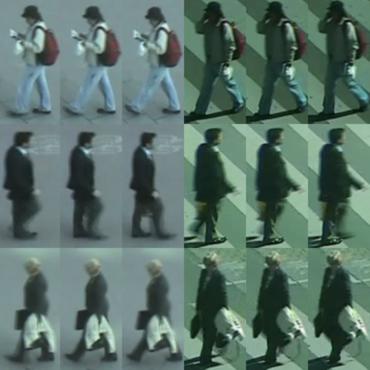Person Re-Identification
510 papers with code • 34 benchmarks • 57 datasets
Person Re-Identification is a computer vision task in which the goal is to match a person's identity across different cameras or locations in a video or image sequence. It involves detecting and tracking a person and then using features such as appearance, body shape, and clothing to match their identity in different frames. The goal is to associate the same person across multiple non-overlapping camera views in a robust and efficient manner.
Libraries
Use these libraries to find Person Re-Identification models and implementationsSubtasks
-
 Unsupervised Person Re-Identification
Unsupervised Person Re-Identification
-
 Video-Based Person Re-Identification
Video-Based Person Re-Identification
-
 Generalizable Person Re-identification
Generalizable Person Re-identification
-
 Cloth-Changing Person Re-Identification
Cloth-Changing Person Re-Identification
-
 Cloth-Changing Person Re-Identification
Cloth-Changing Person Re-Identification
-
 Large-Scale Person Re-Identification
Large-Scale Person Re-Identification
-
 Cross-Modal Person Re-Identification
Cross-Modal Person Re-Identification
-
 Self-Supervised Person Re-Identification
Self-Supervised Person Re-Identification
-
 Clothes Changing Person Re-Identification
Clothes Changing Person Re-Identification
-
 Image-To-Video Person Re-Identification
Image-To-Video Person Re-Identification
-
 Semi-Supervised Person Re-Identification
Semi-Supervised Person Re-Identification
-
 Direct Transfer Person Re-identification
Direct Transfer Person Re-identification
-
 Federated Lifelong Person ReID
Federated Lifelong Person ReID
Most implemented papers
Deep Residual Learning for Image Recognition
Deep residual nets are foundations of our submissions to ILSVRC & COCO 2015 competitions, where we also won the 1st places on the tasks of ImageNet detection, ImageNet localization, COCO detection, and COCO segmentation.
MobileNetV2: Inverted Residuals and Linear Bottlenecks
In this paper we describe a new mobile architecture, MobileNetV2, that improves the state of the art performance of mobile models on multiple tasks and benchmarks as well as across a spectrum of different model sizes.
Densely Connected Convolutional Networks
Recent work has shown that convolutional networks can be substantially deeper, more accurate, and efficient to train if they contain shorter connections between layers close to the input and those close to the output.
A Simple Framework for Contrastive Learning of Visual Representations
This paper presents SimCLR: a simple framework for contrastive learning of visual representations.
Simple Online and Realtime Tracking with a Deep Association Metric
Simple Online and Realtime Tracking (SORT) is a pragmatic approach to multiple object tracking with a focus on simple, effective algorithms.
PointNet++: Deep Hierarchical Feature Learning on Point Sets in a Metric Space
By exploiting metric space distances, our network is able to learn local features with increasing contextual scales.
ShuffleNet: An Extremely Efficient Convolutional Neural Network for Mobile Devices
We introduce an extremely computation-efficient CNN architecture named ShuffleNet, which is designed specially for mobile devices with very limited computing power (e. g., 10-150 MFLOPs).
Improved Baselines with Momentum Contrastive Learning
Contrastive unsupervised learning has recently shown encouraging progress, e. g., in Momentum Contrast (MoCo) and SimCLR.
Domain-Adversarial Training of Neural Networks
Our approach is directly inspired by the theory on domain adaptation suggesting that, for effective domain transfer to be achieved, predictions must be made based on features that cannot discriminate between the training (source) and test (target) domains.
In Defense of the Triplet Loss for Person Re-Identification
In the past few years, the field of computer vision has gone through a revolution fueled mainly by the advent of large datasets and the adoption of deep convolutional neural networks for end-to-end learning.


































 Market-1501
Market-1501
 CUHK03
CUHK03
 DukeMTMC-reID
DukeMTMC-reID
 MARS
MARS
 VIPeR
VIPeR
 CUHK-SYSU
CUHK-SYSU
 SYSU-MM01
SYSU-MM01
 PRW
PRW
 Occluded REID
Occluded REID


